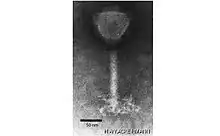Okubovirus
| Okubovirus | |
|---|---|
 | |
| Virion of genus Okubovirus | |
| Virus classification | |
| (unranked): | Virus |
| Realm: | Duplodnaviria |
| Kingdom: | Heunggongvirae |
| Phylum: | Uroviricota |
| Class: | Caudoviricetes |
| Order: | Caudovirales |
| Family: | Herelleviridae |
| Subfamily: | Spounavirinae |
| Genus: | Okubovirus |
Okubovirus is a genus of viruses in the order Caudovirales, in the family Herelleviridae, in the subfamily Spounavirinae.[1] Bacteria serve as natural hosts. There are two species in this genus.[1][2][3][4]
Taxonomy
The following two species are assigned to the genus:[4]
- Bacillus virus Camphawk
- Bacillus virus SPO1
Structure
Viruses in Okubovirus are non-enveloped, with head-tail geometries, and T=16 symmetry. The diameter is around 108 nm, with a length of 140 nm. Genomes are linear, around 145kb in length. The genome codes for 200 proteins.[1][2]
| Genus | Structure | Symmetry | Capsid | Genomic arrangement | Genomic segmentation |
|---|---|---|---|---|---|
| Okubovirus | Head-Tail | T=16 | Non-enveloped | Linear | Monopartite |
Life cycle
Viral replication is cytoplasmic. Entry into the host cell is achieved by adsorption into the host cell. DNA-templated transcription is the method of transcription. Bacteria serve as the natural host. Transmission routes are passive diffusion.[1][2]
| Genus | Host details | Tissue tropism | Entry details | Release details | Replication site | Assembly site | Transmission |
|---|---|---|---|---|---|---|---|
| Okubovirus | Bacteria | None | Injection | Lysis | Cytoplasm | Cytoplasm | Passive diffusion |
Taxonomic history
- Bacillus phage SP8 was assigned to the family Myoviridae in 1995.
- Bacillus phage SPO1 was assigned to the genus SPO1-like phages in 1996 as type species.
- Myoviridae were assigned to the order Caudovirales in 1998
- SPO1-like phages were renamed SPO1-like viruses in 1999
- Bacillus phage SP8 was merged into Bacillus phage SPO1 in 1999 (as type species) of SPO1-like viruses.
- SPO1-like viruses were assigned to the sub-family Spounavirinae (of Caudovirales) in 2011.
- SPO1-like viruses were renamed Spounalikevirus in 2012.
- Spounalikevirus was renamed to Spo1virus in 2015.
- Spo1virus was renamed to Okubovirus in 2018.
References
- 1 2 3 4 "ICTV Report Herelleviridae".
- 1 2 3 "Viral Zone". ExPASy. Retrieved 1 July 2015.
- ↑ Encyclopedia of Virology. p. 1681.
- 1 2 "Virus Taxonomy: 2020 Release". International Committee on Taxonomy of Viruses (ICTV). March 2021. Retrieved 11 May 2021.
External links
This article is issued from Offline. The text is licensed under Creative Commons - Attribution - Sharealike. Additional terms may apply for the media files.